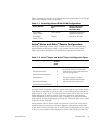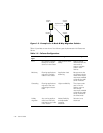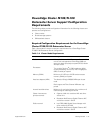
1-6 User’s Guide
However, this configuration is appropriate for business-critical systems since the
application can use the full power of another cluster node in case one cluster node
fails.
NOTE: For clarity, future references of active
n
/active and active
n
/passive configura-
tions will use “n” to equal the number of active cluster nodes. For example, an
active/active/active/active configuration consisting of four active cluster nodes will be
referred to as an active
4
configuration.
Failover and Failback Support
One of the key features of Cluster Service is failover and failback support. Failover is
the process of automatically moving resources from a failed cluster node to other
healthy node(s) in the cluster. Failback is the process of returning the resources back
to the original cluster node. Both failover and failback can be an automatic or manual
process, depending on how you configure the Cluster Service.
NOTE: For more information on failover, failback, and cluster groups, see “Configuring
Failover and Failback Support” in Chapter 6, “Configuring the System Software.”
PowerEdge Cluster FE100/FL100
Datacenter Server Failover Options
The PowerEdge FE100/FL100 Datacenter Server configuration provides the following
failover options:
• N + 1
• Multiway
• Cascading
• N-Way migration solution
The following subsections describe each of these failover options.
N+1 Failover
N+1 failover is an active
n
/passive failover solution where one cluster node provides
backup for multiple cluster nodes. This solution provides the following features:
Advantage:
• One cluster node is a dedicated backup node for all cluster nodes, providing the
best solution for critical applications.
Disadvantages
• High expense, as one node is not used to provide network resources.
• Backup cluster node may lack the resources to support multiple cluster node
failures.
Figure 1-2 shows an example of N + 1 failover configuration.


















